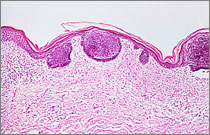Hodgkin lymphoma
| 2020 | ||
|---|---|---|
¹ per 100,000 persons, age-standardised according to the old European standard population * calculated using the period method for 2019 / 2020 | ||
| Women | Men | |
| Incidence | 990 | 1,460 |
| Age-standardised incidence rate¹ | 2.5 | 3.3 |
| Deaths | 127 | 185 |
| Age-standardised mortality rate¹ | 0.1 | 0.3 |
| 5-year prevalence | 4,400 | 6,100 |
| 10-year prevalence | 8,200 | 11,000 |
| Relative 5-year survival rate* | 87 % | 87 % |
| Relative 10-year survival rate* | 84 % | 82 % |
Hodgkin lymphoma is a rare disease diagnosed in approximately 990 women and 1,460 men in Germany in 2020.
Between the ages of 15 and 35, this disease is one of the five most frequently diagnosed cancers. The lifetime risk of developing Hodgkin lymphoma is 0.2 percent for women and 0.3 percent for men.

![]() Age-specific incidence rates by sex, ICD-10 C81, Germany 2017 – 2018, per 100,000
Age-specific incidence rates by sex, ICD-10 C81, Germany 2017 – 2018, per 100,000
Since the middle of the 2000s, there has been a slight increase in the incidence of Hodgkin lymphoma, while fewer and fewer people have died from it. In 2020 the number of deaths due to Hodgkin lymphoma in Germany was just over 300, nearly 200 fewer than at the end of the 1990s.
The prognosis is correspondingly favourable, with a relative survival five years after diagnosis of about 87 percent for women and 83 percent after ten years. Due to the good prognosis and potential for chronic recurrence, long-term survival may also be influenced by the side effects of therapy (including secondary tumours).
Risk factors only partially known
Risk factors for Hodgkin lymphoma are only partially understood. Congenital diseases of the immune system or acquired immune deficiencies, for example due to HIV infection, can increase the risk of Hodgkin lymphoma.
Epstein-Barr virus (EBV), the causative agent of infectious mononucleosis, can play a causal role in the development of Hodgkin lymphoma. However, this probably applies to only some cases of Hodgkin lymphoma. Whether lifestyle-related risk factors or environmental risks are responsible for the development of Hodgkin lymphoma is still unclear. Prolonged cigarette consumption may increase the risk.
Children and siblings of those affected have a slightly increased risk of contracting Hodgkin lymphoma themselves. The interrelationships of this association have not yet been fully clarified and are currently being researched.
Overall, for most Hodgkin lymphoma patients no clear cause can be identified. Presumably, several factors must interact before Hodgkin lymphoma develops.
Date: 21.03.2024






